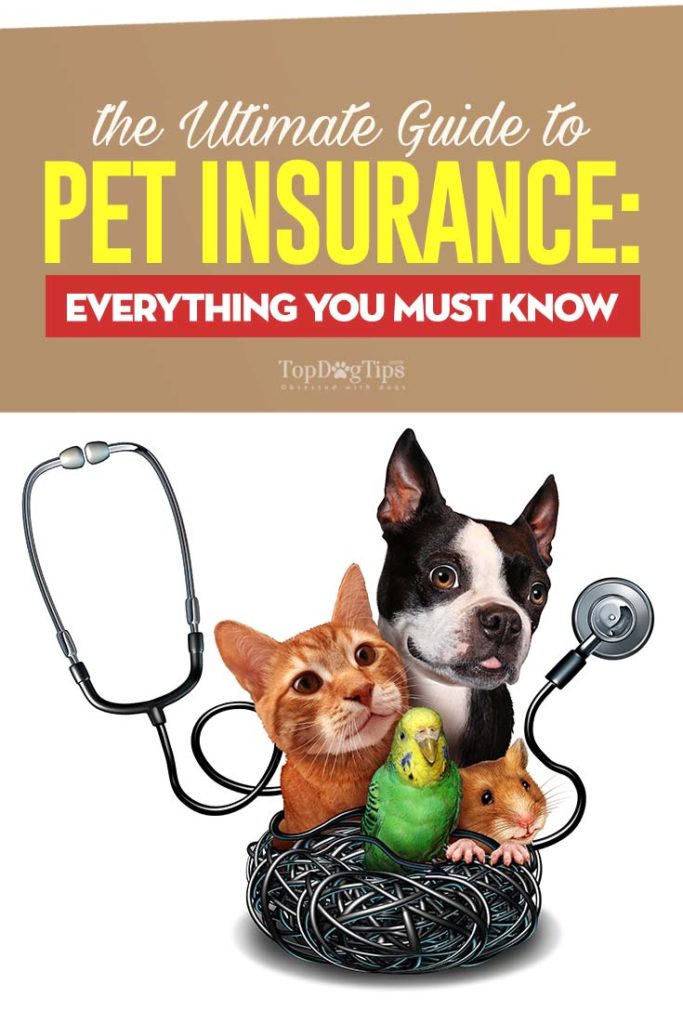
Table of Contents
- How Pet Insurance Works
- What to Consider Before Choosing a Pet Insurance Plan
- Pet Insurance: A Beginner's Guide
- Take Home Message
With so many pet insurance programs on the market, it’s hard to know which one offers the best coverage (and pricing) for your and your dog's needs. In this ultimate pet insurance guide, we'll cover all the ins and outs.
There are a lot of variables to consider when choosing the right pet insurance plan.
Just like your own health insurance, you'll need to research the options available and find the one that will best fit the pet based on many different criteria.
How Pet Insurance Works
In some ways, pet insurance works the same way as your own health insurance does, but there are also several differences that I will note further in the article.
Basically, each month, you will pay a premium for your pet insurance plan. When you make a claim on your plan, you may be required to meet a “per incident” or “per year” deductible before the company will provide any reimbursement.
After you meet the necessary deductible, you may also be required to pay a co-pay on every claim.
Confusing yet? Don't worry. I will explain all this pet insurance jargon below.
Now, the remaining balance will be reimbursed to you by the insurance policy up to any maximum payout caps that apply.
Claims on a dog's hereditary conditions and pre-existing conditions will generally not be reimbursed by most pet insurance plans.
What to Consider Before Choosing a Pet Insurance Plan
The first thing to think about is your dog's pre-existing or hereditary medical condition.
Consider whether the veterinary care needs of your pet will be covered under the plans that you can afford.
For example, if your pet has a pre-existing condition that is not covered but requires costly medication, you may be better served to just invest the amount you would spend on monthly premiums into a vet care fund for your dog.
If your pet has no pre-existing medical conditions at the time of enrollment, pet insurance may be a good investment for you.
This is particularly true if you are bad at money management and find yourself lacking in times of emergency.
Veterinary care can be costly even if your dog is generally healthy, but that's where pet insurance works best.
In short, pet insurance is an investment that provides reimbursement for your dog’s veterinary care costs.
This reimbursement is particularly helpful in times of significant veterinary bills, such as when your dog breaks a leg or is hit by a car.
Pet insurance isn’t the right choice for everyone, however, and we'll discuss this further in the article.
ALSO SEE: 19 Tips to Pick the Best Pet Insurance Plan
Pet Insurance: A Beginner's Guide
The Basics of Pet Insurance Plans
Pet insurance can be just as confusing as human health insurance.
To guarantee yourself and your dog the best pet insurance plan, it’s important to understand the basic elements of all pet insurance plans.
You will need to keep all this terminology in mind when you do a pet insurance plan review to assess whether it's worth it or not.
Here are the most common pet insurance terms you'll need to know:
1. Premiums
Your premium is your monthly payment to the pet insurance company.
This amount will vary based on your level of coverage, and it may also vary based on your pet’s age.
2. Deductibles
Your deductible is the amount that you must pay before your pet insurance company begins paying.
Some plans have a “per incident” deductible (for every incident, you must pay X amount of dollars before insurance coverage kicks in), and some plans have annual deductibles (you must pay X amount per year before insurance coverage kicks in).
3. Co-Pay
Your co-pay is the percentage of the cost that you must pay out-of-pocket per claim once your deductible has been met.
Not all pet insurance plans have a co-pay system in place.
4. Maximum Payout
This is the term used for how much the insurance company will pay out in total.
There are a number of different “maximum payout” systems. These systems vary depending on the plan you select.
5. Maximum Per Incident Payout
This is the maximum amount your pet’s insurance policy will pay out for a single incident.
If a veterinary care procedure exceeds this maximum payout, you will not receive any additional reimbursement and will need to pay the rest out of your own pocket.
6. Maximum Per Year Payout
This is the maximum amount the dog insurance policy will pay out in a single policy year. This maximum may be reached in a single claim or over numerous claims.
Once you reach your annual payout maximum, you will receive no more payout from the pet insurance company on any claims until the next calendar year begins.
7. Maximum Lifetime Payout
This is the maximum amount that your pet’s insurance policy will pay out over the lifetime of the policy.
Once this amount has been reached, you will no longer receive payment for claims, meaning that your pet insurance policy plan has essentially expired.
8. Maximum Per Bodily System Payout
This is the maximum amount that your dog's insurance policy will pay out on a single bodily system (cardiovascular, hepatic, etc.) over the life of the policy.
Once this maximum has been reached, you will receive no reimbursement for claims relating to this bodily system. Note that not all pet insurance policies have this type of maximum payout.
9. Hereditary Conditions
A hereditary condition is a condition inherited by your pet from his parents. It's something that he's born with.
Most pet insurance policies will not provide coverage for hereditary conditions. An example of this type of condition is hip dysplasia.
10. Pre-Existing Conditions
This is the term used for any condition that your pet has before you purchase a dog insurance policy.
Like hereditary conditions, most pet insurance policies will not provide coverage for pre-existing conditions.
An example of this type of condition is a dog who has already been diagnosed with arthritis prior to the beginning of their policy.
Dog Insurance Coverage Types
As with human health insurance, there are different levels of pet insurance coverage for dogs.
Determining which type and level is right for you and your pet depends on your budget as well as your projected veterinary needs, which you'll need to consider thoroughly before making a choice.
The three different types of dog insurance coverage available for pet owners include:
1. Routine Healthcare Coverage and Emergency Coverage (High Premiums, Broader Coverage)
For complete coverage, this type of pet insurance plan is ideal in that it covers a lot.
This plan covers necessary routine veterinary care such as the dog's annual exams, dental cleanings, and vaccinations, as well as illness and emergency visits.
These plans are often cost-prohibitive and are not the most popular option among dog owners.
2. Standard Coverage or Illness, Injury Coverage
(Mid-Range Premiums, Mid-Range Coverage)
This “middle-of-the-road” pet insurance plan is the most popular among dog owners.
This type provides coverage for a dog's illness or injury as well as emergency and catastrophic events. This plan does not, however, cover any routine care.
This is the most favorable plan, as it provides coverage for more costly procedures and events, which is exactly when you'd like some financial help with covering veterinary bills.
3. Emergency or Catastrophic Coverage
(Low Premiums, Less Coverage)
This is the most affordable insurance plan for your pet, but it provides minimal coverage.
Only emergency or catastrophic events are covered (a dog was hit by a car, got cancer, etc.) This is not the best pet insurance plan, nor should you expect to use it frequently, but it is a good plan to have in place if your pet experiences a significant illness or injury.
If you're on the fence about getting dog insurance coverage, this may be ideal to start.
How to Choose the Right Coverage Type
The pet insurance plan for dogs that you choose will depend primarily on your budget. So, you must first think about how much you are able to afford for your monthly premium.
Your second consideration should be your pet’s current health condition. If you have an adult dog, for example, does he have allergies or symptoms of lupus?
If so, you will want to consider a policy that offers more comprehensive coverage to avoid financial burdens.
If you have a puppy or young adult dog, you should also do some research on health conditions that are common for that specific breed.
For instance, if you have a Labrador Retriever, you should consider purchasing a dog insurance plan that will cover some of the orthopedic conditions or eye issues that are commonly seen in this dog breed.
If you want to make the absolute best choice and pick the best pet insurance plan for your dog, then you'll need to spend some time doing the research and making some lists. When you take the above into consideration, the end result will be a winner for you.
Filing Pet Insurance Claims
Let's say you've picked the best pet insurance plan for dogs in your home. But now, the emergency strikes, and you need to take advantage of your insurance policy. How do you do that?
Unlike human health insurance, pet health insurance requires you to pay your vet bill in full before filing a claim with the pet insurance company.
Once you file your claim for reimbursement and that claim has been processed, you will receive a payment based on your plan’s deductible and maximum payout caps.
Usually, claims can be filed via e-mail, fax, or regular mail, but different insurance policies have different requirements for filing claims.
Some require a veterinarian's signature on each claim and some simply require a copy of an itemized receipt. Always pay close attention to these and other requirements before you sign on the dotted line.
Some pet insurance plans have time limitations by when you must file your claim in order to be reimbursed.
You are responsible for filing your own claims within a timely period following your dog’s care. Make sure you read the pet insurance policy's terms of this.
Again, it's a very important consideration—you need to be clear on any specific time limitations prior to signing up for a pet insurance policy.
Obviously, it is always advisable to file claims as soon as possible since faster filing means faster reimbursement.
Note that processing times for claims vary on a per-company basis.
Depending on the pet insurance company you choose, claims may be processed within weeks, while with others, it may take months.
You can usually get an idea of how quickly a company processes claims based on pet insurance reviews from their customers.
Once claims have been processed, most pet insurance companies pay their reimbursement to you via check. Checks are sent directly to you within two weeks of claims processing.
RELATED: 15 Cheap Ways To Prevent Most Common Health Issues in Dogs
Popular Pet Insurance for Dogs Companies
There are increasing numbers of companies that provide pet insurance for dogs and cats.
Some of them are good, and some are not so good based on personal criteria.
But there is a core group of pet insurance providers that have gotten great reviews over the years. These companies are well-established and have plans that offer the best coverage prices.
I'll briefly introduce you to the six most popular U.S. pet insurance companies, but it's best for you to go to their websites and review their pet insurance plans for a better picture.
1. Healthy Paws
Healthy Paws has an annual deductible on their plans and provides comprehensive accident and illness coverage. They have no caps on their claims and unlimited lifetime benefits.
2. Pet Plan
Pet Plan Pet insurance has varying levels of annual deductibles on their plans, ranging from $100 to $1,000.
They offer comprehensive coverage for dogs, which includes vet exam fees. Annual reimbursement varies, but it can be unlimited.
3. Embrace Insurance
Embrace pet insurance offers accident and illness coverage for dogs, and their plans have varying annual deductibles ranging from $200 to $1,000.
Embrace pet insurance also offers prescription coverage and wellness visit coverage, but they are both optional. Annual benefits are limited to $15,000.
4. Nationwide Insurance
Nationwide pet insurance has an annual deductible of $250, and it does not cap the number of claims that can be made in a year.
Nationwide dog insurance does cover most hereditary and congenital conditions, but there may be “waiting periods” on claims relating to those conditions.
Nationwide does offer wellness plans that cover non-illness and non-injury-related costs.
5. Pet First
Pet First pet insurance plans have three annual limit options ranging from $5,000 to $20,000. Deductibles are per incident and range from $50 to $500.
Reimbursement options range from 90% to 70%. Pet First insurance also offers coverage for congenital, hereditary, and chronic illnesses, but they do not cover pre-existing conditions.
6. Pets Best
Pets Best pet insurance plans for dogs offer annual limitations of $5,000 or an unlimited plan, as well as no limitations on congenital or hereditary conditions. Deductibles range from $50 to $1,000 per year, and reimbursement levels range from 90% to 70%. Plans cover accident-only claims or accident and illness claims, and there is also the option of adding rehabilitative coverage for the dog.
A word of warning
Keep in mind that you should always check to make sure that your vet will work with a particular pet insurance plan or company before selecting it. Always call them up to confirm.
Although most vet clinics will work with all pet insurance plans since they never have to file claims for you, it is always best to double-check before enrollment.
What to Prioritize When Choosing Pet Insurance
 As you can see, there is a lot to consider when choosing the best pet insurance plan. So what should take priority?
As you can see, there is a lot to consider when choosing the best pet insurance plan. So what should take priority?
For most families with dogs, pet insurance coverage type is the top priority when selecting a plan. For a pet insurance plan to be beneficial, it must offer coverage for the things that you'll be needing coverage for, and that means you'll need to plan and guess.
After you pick the best pet insurance coverage type for your dog, the second most important consideration is benefit limitations. Limits on benefits determine how much can be made in pet insurance claims per year or through the lifetime of a policy.
Limits also determine how much will be paid out to you for veterinary care during a certain period or for a certain condition. For a pet insurance plan to be beneficial, it must cover enough benefits and pay out enough annually to be worth the investment.
The third thing to consider is all the rest – pet insurance plan costs, customer reviews, claims processing (method and timing), and service itself.
The fourth and final thing to consider is the deductibles and reimbursement models, which are of less significance when choosing a plan but should still be taken into consideration.
Take Home Message
In conclusion, pet insurance is not for everybody. To know if it's a good fit for you, think about your dog's current health condition and do the math on how much you'd pay.
If you've read the article fully, you should be able to pick the best pet insurance plan for dogs once you take the time to consider all the variables and prioritize well.
Do not rush to choose the most popular plan. Make a list, review all pet insurance companies and their plans, and see how they are fair against each other.
















